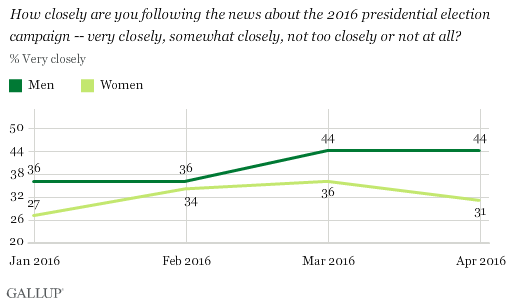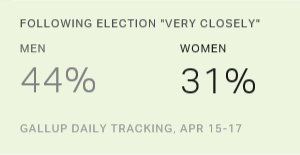Story Highlights
- 44% of men following election very closely, compared with 31% of women
- Gender gap larger in April than in previous months
- Gap exists among both Republicans and Democrats
PRINCETON, N.J. -- Men over the last two months have been paying significantly more attention to news about the 2016 presidential election than are women. In April, 44% of men say they are following election news very closely, compared with 31% of women. This 13-percentage-point gap has expanded from previous months, particularly February, when the gap was a narrow two points.

This measure of attention paid to the campaign is based on Gallup Daily tracking interviews conducted since January, in the middle of each month, with the latest update from April 15-17. Men's attention to the election increased in March and remains unchanged in April, while women's stayed about the same in February and March, but dropped five points in April. Complete results are at the end of this article.
As is usually the case, Republicans (48%) are following news of the election significantly more closely than are Democrats (34%). Men are more likely than women to identify as Republicans, suggesting that one possible explanation for the gender gap could be underlying gender differences in partisan composition.
But the gender gap persists within both parties. An aggregated analysis of March and April responses shows that Republican men are eight points more likely than Republican women to be following the election very closely, while Democratic men are 11 points more likely than Democratic women. "Pure" independents -- those who do not lean to either party -- are following the news less closely than those in either party, regardless of gender, as would be expected. But even with overall lower levels of interest, independent men are significantly more likely than independent women to say they are following the news very closely.
How Closely Following News About Election, by Gender and Party
% Very closely
| Men | Women | Difference | |||||||||||||||||||||||||||||||||||||||||||||||||||||||||||||||||||||||||||||||||||||||||||||||||
| % | % | (pct. pts.) | |||||||||||||||||||||||||||||||||||||||||||||||||||||||||||||||||||||||||||||||||||||||||||||||||
| REPUBLICANS/LEANERS | 52 | 44 | +8 | ||||||||||||||||||||||||||||||||||||||||||||||||||||||||||||||||||||||||||||||||||||||||||||||||
| INDEPENDENTS/NO LEAN | 24 | 6 | +18 | ||||||||||||||||||||||||||||||||||||||||||||||||||||||||||||||||||||||||||||||||||||||||||||||||
| DEMOCRATS/LEANERS | 41 | 30 | +11 | ||||||||||||||||||||||||||||||||||||||||||||||||||||||||||||||||||||||||||||||||||||||||||||||||
| March 16-17 and April 15-17, 2016 | |||||||||||||||||||||||||||||||||||||||||||||||||||||||||||||||||||||||||||||||||||||||||||||||||||
| Gallup Daily tracking | |||||||||||||||||||||||||||||||||||||||||||||||||||||||||||||||||||||||||||||||||||||||||||||||||||
Age, too, does not appear to be a direct factor in this relationship. The gender gap in the percentages who very closely follow election news persists across all three major age groups: nine points among those 18 to 34 years old, 14 points among 35- to 54-year-olds and 13 points among those 55 and older.
How Closely Following News About Election, by Gender and Age
% Very closely
| Men | Women | Difference | |||||||||||||||||||||||||||||||||||||||||||||||||||||||||||||||||||||||||||||||||||||||||||||||||
| % | % | (pct. pts.) | |||||||||||||||||||||||||||||||||||||||||||||||||||||||||||||||||||||||||||||||||||||||||||||||||
| 18-34 | 26 | 17 | +9 | ||||||||||||||||||||||||||||||||||||||||||||||||||||||||||||||||||||||||||||||||||||||||||||||||
| 35-54 | 46 | 32 | +14 | ||||||||||||||||||||||||||||||||||||||||||||||||||||||||||||||||||||||||||||||||||||||||||||||||
| 55+ | 57 | 44 | +13 | ||||||||||||||||||||||||||||||||||||||||||||||||||||||||||||||||||||||||||||||||||||||||||||||||
| March 16-17 and April 15-17, 2016 | |||||||||||||||||||||||||||||||||||||||||||||||||||||||||||||||||||||||||||||||||||||||||||||||||||
| Gallup Daily Tracking | |||||||||||||||||||||||||||||||||||||||||||||||||||||||||||||||||||||||||||||||||||||||||||||||||||
The gender gap in paying attention to the election also persists regardless of education level. Attention to the news is generally higher as education level increases, but men with a college degree are more likely than degree-holding women to be paying close attention to election news (a 16-point gap), and the trend is consistent with men and women without college degrees (a 10-point gap).
How Closely Following News About Election, by Gender and Education
% Very closely
| Men | Women | Difference | |||||||||||||||||||||||||||||||||||||||||||||||||||||||||||||||||||||||||||||||||||||||||||||||||
| % | % | (pct. pts.) | |||||||||||||||||||||||||||||||||||||||||||||||||||||||||||||||||||||||||||||||||||||||||||||||||
| COLLEGE GRADUATE | 59 | 43 | +16 | ||||||||||||||||||||||||||||||||||||||||||||||||||||||||||||||||||||||||||||||||||||||||||||||||
| NOT COLLEGE GRADUATE | 38 | 28 | +10 | ||||||||||||||||||||||||||||||||||||||||||||||||||||||||||||||||||||||||||||||||||||||||||||||||
| March 16-17 and April 15-17, 2016 | |||||||||||||||||||||||||||||||||||||||||||||||||||||||||||||||||||||||||||||||||||||||||||||||||||
| Gallup Daily Tracking | |||||||||||||||||||||||||||||||||||||||||||||||||||||||||||||||||||||||||||||||||||||||||||||||||||
Implications
Men are more likely than women to be Republicans, and not only is overall Republican interest higher in this election so far, but turnout in Republican primaries has also been higher. But even within ranks of both parties, men are paying more attention than women -- indicating there is more causing the gap in attention to the election than just the underlying fact that Republicans are more interested than Democrats so far this year.
Much of the news coverage in this year's presidential campaign has been focused on Donald Trump, and data from the April survey indicate that his supporters are more likely than those who support any of the other major candidates to say they are following the news very closely. Since Trump's supporters skew male, it could be that the Trump factor is helping fuel the higher male interest within the ranks of Republicans. But that doesn't help explain the gender gap among Democrats.
Data show that there has been a gender gap in attention paid to historical elections as well. One possible, although difficult-to-document hypothesis, is that the general absence of women as candidates for the major parties' nominations over time could be a factor in women's overall lower attention to the race. Even this year, despite the presence of Hillary Clinton as the Democratic front-runner, only one other individual out of the more than 20 candidates who began the presidential race is a woman -- Carly Fiorina.
The implications of the gender gap in election interest are unclear at this point. Women may well vote at their usual levels -- women constituted 53% of the presidential vote in 2012 based on exit polling -- even if their interest levels stay relatively low. It's also entirely possible that women's relative interest may pick up once the two parties hold their conventions in July and the nominees are solidified.
How Closely Following News About Election, by Gender and Month
| Very closely | Somewhat closely | Not too closely | Not at all closely | ||||||||||||||||||||||||||||||||||||||||||||||||||||||||||||||||||||||||||||||||||||||||||||||||
| % | % | % | % | ||||||||||||||||||||||||||||||||||||||||||||||||||||||||||||||||||||||||||||||||||||||||||||||||
| JANUARY | |||||||||||||||||||||||||||||||||||||||||||||||||||||||||||||||||||||||||||||||||||||||||||||||||||
| Men | 36 | 36 | 20 | 8 | |||||||||||||||||||||||||||||||||||||||||||||||||||||||||||||||||||||||||||||||||||||||||||||||
| Women | 27 | 40 | 23 | 8 | |||||||||||||||||||||||||||||||||||||||||||||||||||||||||||||||||||||||||||||||||||||||||||||||
| FEBRUARY | |||||||||||||||||||||||||||||||||||||||||||||||||||||||||||||||||||||||||||||||||||||||||||||||||||
| Men | 36 | 36 | 18 | 10 | |||||||||||||||||||||||||||||||||||||||||||||||||||||||||||||||||||||||||||||||||||||||||||||||
| Women | 34 | 37 | 19 | 9 | |||||||||||||||||||||||||||||||||||||||||||||||||||||||||||||||||||||||||||||||||||||||||||||||
| MARCH | |||||||||||||||||||||||||||||||||||||||||||||||||||||||||||||||||||||||||||||||||||||||||||||||||||
| Men | 44 | 34 | 15 | 6 | |||||||||||||||||||||||||||||||||||||||||||||||||||||||||||||||||||||||||||||||||||||||||||||||
| Women | 36 | 35 | 24 | 5 | |||||||||||||||||||||||||||||||||||||||||||||||||||||||||||||||||||||||||||||||||||||||||||||||
| APRIL | |||||||||||||||||||||||||||||||||||||||||||||||||||||||||||||||||||||||||||||||||||||||||||||||||||
| Men | 44 | 34 | 15 | 6 | |||||||||||||||||||||||||||||||||||||||||||||||||||||||||||||||||||||||||||||||||||||||||||||||
| Women | 31 | 43 | 19 | 7 | |||||||||||||||||||||||||||||||||||||||||||||||||||||||||||||||||||||||||||||||||||||||||||||||
| Gallup Daily Tracking | |||||||||||||||||||||||||||||||||||||||||||||||||||||||||||||||||||||||||||||||||||||||||||||||||||
These data are available in Gallup Analytics.
Survey Methods
Results for this Gallup poll are based on telephone interviews conducted April 15-17, 2016, on the Gallup U.S. Daily survey, with a random sample of 1,537 adults, aged 18 and older, living in all 50 U.S. states and the District of Columbia. For results based on the total sample of national adults, the margin of sampling error is ±3 percentage points at the 95% confidence level.
For results based on the sample of 719 Republicans and Republican-leaning independents, the margin of error is ±5 percentage points at the 95% confidence level. For results based on the sample of 672 Democrats and Democratic-leaning independents, the margin of error is ±5 percentage points at the 95% confidence level. All reported margins of sampling error include computed design effects for weighting.
Each sample of national adults includes a minimum quota of 60% cellphone respondents and 40% landline respondents, with additional minimum quotas by time zone within region. Landline and cellular telephone numbers are selected using random-digit-dial methods.
View complete question responses and trends.
Learn more about how Gallup Daily tracking works.


